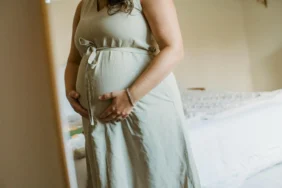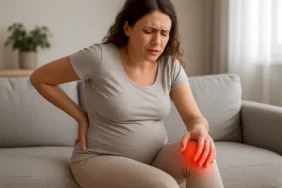Pregnancy contractions are a fundamental part of the journey to childbirth, and understanding their significance and variations throughout gestation is crucial. Beginning with a clear definition and the early signs and symptoms to watch for, particularly around 33 weeks, this overview emphasizes the importance of recognizing true versus false contractions and knowing when to seek medical advice. Practical tips on managing contractions during pregnancy are also offered, ensuring expectant mothers feel prepared and informed. Additionally, insights into what to expect from contractions following the birth provide a well-rounded resource, empowering readers with essential knowledge for navigating the complexities of pregnancy and labor.
What Are Pregnancy Contractions?
Pregnancy contractions refer to the tightening and relaxing of the muscles of the uterus, which can occur at various stages during pregnancy. These contractions are an important part of the body’s preparation for labor and help to facilitate the birth process. Understanding the timing and type of contractions during pregnancy can significantly aid expectant mothers in recognizing what is normal and what might require medical attention.
- Braxton Hicks Contractions: Often referred to as “practice contractions,” these can occur as early as the second trimester and are generally painless.
- Early Labor Contractions: Typically are more rhythmic and stronger than Braxton Hicks, indicating that the body is preparing for delivery.
- Frequency: Regular contractions accompanying a pattern can signify that labor is approaching.
- Duration: Each contraction usually lasts between 30 to 70 seconds during true labor.
- Intensity: As labor progresses, contractions will become more intense and frequent.
- Timing: Tracking the intervals can help determine if it’s time to head to the hospital.
As your pregnancy progresses, it is essential to differentiate between false labor pains and genuine contractions. Initially, you may experience mild contractions that are irregular, which can be confusing and contribute to pregnancy anxiety. However, true contractions during pregnancy typically exhibit a consistent pattern. Understanding these distinctions can prevent unnecessary pregnancy anxiety and assist in managing expectations as the due date approaches.
Recognizing the signs of true pregnancy contractions can empower expectant mothers, helping them to be better prepared for the experience of childbirth.
In conclusion, pregnancy contractions are a natural and vital part of the journey toward childbirth. By familiarizing yourself with what to expect, such as the characteristics of contractions during pregnancy, you can navigate this transformative time with greater ease and confidence. Always consult with a healthcare provider if there are any concerns regarding your contractions to ensure both your health and that of your baby.
Early Contractions in Pregnancy: Signs and Symptoms
Understanding the signs and symptoms of early contractions during pregnancy is essential for expectant mothers. Early contractions, also known as Braxton Hicks contractions, can begin as early as the second trimester and are often described as practice contractions. They prepare the mother’s body for labor but can be confusing when it comes to distinguishing them from true labor contractions. It’s crucial to monitor their frequency and intensity to differentiate them.
The sensation of contractions during pregnancy may vary significantly from one woman to another. Some may experience mild tightening in the abdomen, while others might feel a more intense cramping. Regardless of the feeling, early contractions are typically irregular and may not indicate that labor is imminent. Staying aware of your body can help in identifying pregnancy contractions and knowing when to seek medical advice.
Steps to Identify Early Contractions
- Monitor the frequency of contractions.
- Note the duration of each contraction.
- Assess the intensity of the pain or discomfort.
- Keep track of any triggers, such as physical activity or dehydration.
- Stay hydrated and rest to see if contractions decrease.
- Contact your healthcare provider if the contractions become regular.
- Using a contraction timer can help in recording your symptoms accurately.
Recognizing the signs associated with early contractions is critical for managing your pregnancy effectively. As some women may confuse these early contractions with signs of preterm labor, it is vital to remain informed about the changes your body goes through. Pay attention to any increase in the strength or frequency, as these may require immediate medical consultation.

How to Recognize Contractions During Pregnancy
Recognizing contractions during pregnancy is essential for expectant mothers to ensure a healthy birthing experience. As the body prepares for labor, women may experience various signs that indicate contractions are occurring. These contractions can initiate as early as the second trimester, but distinguishing true labor from Braxton Hicks contractions can be challenging. Learning how to identify these contractions will empower mothers with the knowledge needed to respond appropriately.
| Type of Contraction | Characteristics | When to Seek Help |
|---|---|---|
| Braxton Hicks | Irregular, infrequent, and usually painless | Generally not necessary unless accompanied by other symptoms |
| True Labor | Regular, progressively strong, and increasing in intensity | If contractions are 5 minutes apart or less |
| Preterm Labor | Regular contractions occurring before 37 weeks | Immediate medical attention is required |
| Postpartum Contractions | After delivery, these help the uterus return to its normal size | Can be normal but consult if excessively painful |
As you begin to recognize contractions during pregnancy, a good practice is monitoring their frequency and intensity. This will help you differentiate between the types of contractions you might be experiencing. Remember, it’s common for first-time moms to feel uncertain; hence, maintaining a clear log can be helpful when consulting with healthcare professionals.
Common Signs to Look For
- Increased frequency of contractions
- Regular pattern of contraction intervals
- Intensity of pain increasing over time
- Pelvic pressure or lower back pain
- Watery or bloody discharge along with contractions
- Change in the position of the baby
Identifying the correct timing of contractions is equally critical. Timing of contractions can help healthcare providers determine the stage of labor. Healthcare providers often recommend timing the contractions from the start of one to the start of the next to gauge their regularity. Be aware that contractions can vary in length and strength, so keep track of how long each lasts and how far apart they are.
Timing of Contractions
When it comes to contractions during pregnancy, timing is key. Recorded patterns will assist you in understanding whether you are experiencing false labor or true labor. Early labor contractions may feel irregular and spread apart, typically ranging every 10 to 20 minutes. However, as labor progresses, these contractions usually become closer together and more intense. Effective tracking can make a significant difference in knowing when it’s time to head to the hospital.
Contractions at 33 Weeks of Pregnancy: What You Should Know
As pregnancy progresses, the body undergoes various changes that prepare it for labor. By 33 weeks, many expectant mothers begin to experience pregnancy contractions, which can be an important sign of the body preparing for childbirth. These contractions can start as early as the second trimester but may become more noticeable around this time. Understanding these contractions is crucial for distinguishing between normal symptoms and potential warnings of premature labor.
During this period, contractions may vary in intensity and frequency. Some women may experience Braxton Hicks contractions, which are often characterized as practice contractions. These contractions can feel uncomfortable but typically do not lead to labor. It’s essential to recognize the difference between these and true labor contractions, as this knowledge can help ease concerns as the due date approaches.
Typical Symptoms at 33 Weeks
At 33 weeks, alongside contractions, there are various other symptoms that expectant mothers might experience. It’s important to be aware of these signs to engage in proactive prenatal care and to better understand what their bodies are going through. Typical symptoms may include:
- Increased pelvic pressure
- Back pain
- Changes in baby movement patterns
- Abdominal cramps
- Fatigue and pregnancy insomnia or other sleep disturbances
- Fluid leakage or spotting
Monitoring these symptoms, along with any pregnancy contractions you may experience, is important for assessing your overall health. Maintaining open communication with your healthcare provider can help address any concerns that may arise as you near your due date, especially concerning the impact of pregnancy insomnia on overall well-being.
Important Considerations
- Stay hydrated, as dehydration can exacerbate contractions.
- Track the frequency and duration of contractions to identify patterns.
- Associate any significant changes in symptoms with your healthcare provider.
- Rest as much as possible—fatigue can trigger contractions.
- Consult a physician if contractions become regular or painful.
In summary, being informed about pregnancy contractions and the accompanying symptoms around the 33-week mark can empower expectant mothers. If there are any concerns or unusual symptoms, seeking medical advice can ensure both maternal and fetal health remain a priority as labor approaches.

When Should You Be Concerned About Pregnancy Contractions?
Understanding when to be concerned about contractions pregnancy is crucial for expectant mothers. While some level of contraction is normal as the body prepares for labor, not all contractions are a sign of impending delivery. Early on in pregnancy, contractions may indicate a potential issue, especially if accompanied by other distressing symptoms. Always listen to your body and consult with healthcare professionals if something feels off.
Red Flags to Watch Out For
- Severe or persistent pain
- Regular contractions occurring at intervals of less than 10 minutes
- Vaginal bleeding or unusual discharge
- Signs of premature labor before the 37-week mark
- Fever or chills together with contractions
- Decreased fetal movement
- Severe headaches or visual disturbances
It is essential to differentiate between true labor contractions and Braxton Hicks contractions, which are often just practice contractions. True labor contractions intensify in duration and frequency and are accompanied by other signs, such as water breaking or significant discomfort. If you are experiencing any of the items listed above, seek medical help immediately.
In summary, while contractions pregnancy is a normal part of gestation, being attuned to your body can help you discern when medical intervention is necessary. Keep track of your symptoms and don’t hesitate to reach out to your healthcare provider for guidance, ensuring a safer experience as you approach labor.
Difference Between True and False Contractions in Pregnancy
Understanding the difference between true and false contractions during pregnancy is crucial for expecting mothers. True contractions, often referred to as labor contractions, are those that signify the onset of labor. They occur at regular intervals and intensify with time, pushing the baby down the birth canal. In contrast, false contractions, or Braxton Hicks contractions, are irregular and less intense, often described as practice contractions. They prepare the body for labor without leading to childbirth.
Comparison of True and False Contractions
| Type of Contraction | Characteristics | When They Occur |
|---|---|---|
| True Contractions | Regular, progressively stronger | During labor |
| False Contractions | Irregular, not progressively stronger | Any time after the second trimester |
| Duration | Lasting 30-70 seconds | Vary, usually shorter |
| Pain Level | Increasing pain | Minimal to mild discomfort |
Awareness of these differences helps in recognizing when to seek medical attention. True contractions often indicate that labor is imminent, and being able to identify them can be vital for preparation. On the other hand, understanding that false contractions can occur well before labor can help relieve anxiety. Expecting mothers should keep track of the frequency and intensity of contractions to share with their healthcare provider.
Key Differences
- True contractions occur at regular intervals; false contractions are irregular.
- True contractions intensify over time; false contractions remain inconsistent.
- True contractions are usually painful; false contractions are generally uncomfortable.
- True contractions lead to cervical changes; false contractions do not affect the cervix.
- True contractions signify labor onset; false contractions are simply practice.
- True contractions can occur only towards the end of pregnancy; false contractions can occur any time after midway.
Recognizing these differences in contractions during pregnancy can empower mothers during their birthing experience. Every pregnancy is unique, and what works for one may not apply to another. As contractions become more pronounced, seeking guidance from a healthcare provider is strongly encouraged, especially when determining whether it’s time to head to the hospital.

Managing Pregnancy Contractions: Tips and Advice
When it comes to pregnancy contractions, understanding how to effectively manage them can significantly enhance your comfort and confidence during pregnancy. Contractions can vary in intensity and duration, and knowing how to cope with them helps prepare you for the journey ahead. Ensure you stay informed about when to seek medical advice and recognize the differences between true and false contractions.
Proven Strategies
Here are some effective strategies to manage pregnancy contractions:
- Practice Relaxation Techniques: Deep breathing, meditation, or prenatal yoga can help soothe the body.
- Stay Hydrated: Adequate water intake can reduce the occurrence of Braxton Hicks contractions.
- Change Positions: Shifting your body position can alleviate discomfort during contractions.
- Warm Bath or Shower: Warm water relaxes muscles and may reduce contraction pain.
- Stay Active: Gentle exercise can aid in managing contractions effectively.
- Use a TENS Machine: This can provide additional pain relief for some women.
- Consult Your Healthcare Provider: Always reach out to a professional for personalized guidance.
Monitoring your body and understanding your contractions are crucial aspects of managing your pregnancy. As you experience these changes, remember that each pregnancy is unique. It’s important to respond to your body’s signals and utilize the strategies that work best for you, especially when distinguishing between false and true contractions.
By practicing these strategies, you can create a supportive environment for both you and your baby. Staying connected to your healthcare provider will provide you with invaluable information tailored to your specific circumstances. Remember, being proactive about managing pregnancy contractions can not only ease discomfort but also promote a positive and empowered birthing experience.
Contractions After Pregnancy: What to Expect
After delivering your baby, it’s common to continue experiencing contractions, known as afterpains. These contractions help your uterus return to its pre-pregnancy size and can sometimes be intense, particularly for those who have had multiple pregnancies. It’s essential to understand that while these contractions are a normal part of postpartum recovery, their intensity and frequency can vary significantly from woman to woman.
Common Experiences
- Intensity and Duration: Afterpains typically feel like menstrual cramps and may last for several days to weeks.
- Increased with Breastfeeding: Breastfeeding can stimulate contractions due to the release of oxytocin, which helps the uterus contract.
- Pain Management Needs: Some women might experience discomfort that requires over-the-counter pain relief.
- Timing: Afterpains are usually more pronounced in the first few days post-delivery.
- Variability: The level of discomfort can differ based on individual pain tolerance and prior childbirth experiences.
- Hip Pain After Pregnancy: Many women also experience discomfort in the hips due to pelvic changes during pregnancy and childbirth.
- Signs to Watch: If the pain becomes unbearable or is accompanied by excessive bleeding, consult a healthcare provider.
It’s important to remember that these contractions are beneficial, as they help prevent postpartum hemorrhage by ensuring the uterus contracts effectively.
Normal afterpains should gradually decrease in intensity over time; however, excessive pain or irregularities warrant a discussion with your healthcare provider.
Monitoring your recovery process and understanding the signs of when to seek medical advice will support a healthier postpartum experience.
Ultimately, while contractions after pregnancy can be uncomfortable, they play a critical role in your recovery. Ensuring that you maintain open communication with your healthcare team regarding any concerns will help ease the transition into motherhood. Knowing what to expect can empower you during this new chapter, making it more manageable and enjoyable.




